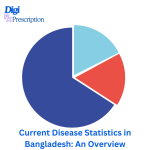
Bangladesh, with its dense population and unique geographical features, faces a myriad of health challenges. Recent data highlights the prevalence of both communicable and non-communicable diseases, influenced by factors such as climate change, urbanization, and environmental conditions.
1. Communicable Diseases
a. Dengue Fever
Dengue fever has emerged as a significant public health concern in Bangladesh.
2023 Outbreak: The country experienced its most severe dengue outbreak in 2023, reporting over 321,000 cases and 1,705 deaths, resulting in a case-fatality rate (CFR) of 0.53%.
PMC.NCBI.NLM.NIH.GOV
2024 Trends: As of November 2024, more than 400 deaths and over 78,595 hospitalizations have been attributed to dengue. The prolonged monsoon season and rising temperatures, likely exacerbated by climate change, have created optimal breeding conditions for Aedes mosquitoes, the primary vectors of dengue.
REUTERS.COM
b. Nipah Virus
Nipah virus infections are seasonal, typically occurring between December and April.
2024 Cases: Between January and February 2024, two laboratory-confirmed cases were reported in the Dhaka division, both of which were fatal. The primary transmission route is believed to be the consumption of raw date palm sap contaminated by fruit bat secretions.
WHO.INT
c. Waterborne Diseases
Frequent flooding, intensified by climate change, has led to outbreaks of waterborne diseases.
2024 Floods: In August 2024, severe floods resulted in at least 54 deaths and left millions stranded. As floodwaters receded, there was a significant rise in waterborne illnesses, with approximately 3,000 hospitalizations reported within 24 hours for conditions such as diarrhea and skin infections.
REUTERS.COM
2. Non-Communicable Diseases (NCDs)
Non-communicable diseases continue to be leading causes of mortality in Bangladesh.
Cardiovascular Diseases: Stroke and ischemic heart disease are among the top causes of death, with mortality rates of 72.3 and 67.6 per 100,000 population, respectively.
DATA.WHO.INT
Chronic Respiratory Diseases: Chronic obstructive pulmonary disease (COPD) accounts for a mortality rate of 34.1 per 100,000 population.
DATA.WHO.INT
Air Pollution Impact: In 2021, air pollution was linked to over 235,000 deaths in Bangladesh. Notably, more than 19,000 children under five years old died from air pollution-related conditions, underscoring the severe impact of environmental factors on public health.
BANGLADESH.UN.ORG
3. Healthcare System Challenges
Bangladesh's healthcare system faces several obstacles:
Resource Allocation: As of 2021, healthcare expenditure constituted approximately 2.36% of the nation's GDP.
EN.WIKIPEDIA.ORG
Workforce Shortage: The country has about 5.3 doctors per 10,000 people, indicating a significant gap in healthcare provider availability.
EN.WIKIPEDIA.ORG
Infrastructure Limitations: With only nine hospital beds per 10,000 people, the healthcare infrastructure is strained, especially during disease outbreaks and natural disasters.
EN.WIKIPEDIA.ORG
Conclusion
Bangladesh continues to grapple with a dual burden of communicable and non-communicable diseases, compounded by environmental challenges and infrastructural limitations. Addressing these issues requires a multifaceted approach, including strengthening healthcare infrastructure, enhancing disease surveillance, and implementing effective public health interventions to mitigate the impacts of climate change and urbanization.
References:
World Health Organization (WHO) – Nipah Virus Infection – Bangladesh
World Health Organization (WHO) – Bangladesh Health Data
UNICEF Bangladesh – Air Pollution Impact on Children
Reuters – Bangladesh Dengue Outbreak
Centers for Disease Control and Prevention (CDC) – CDC in Bangladesh
European Centre for Disease Prevention and Control (ECDC) – Dengue Worldwide Overview
Reuters – Bangladesh Floods and Waterborne Diseases
